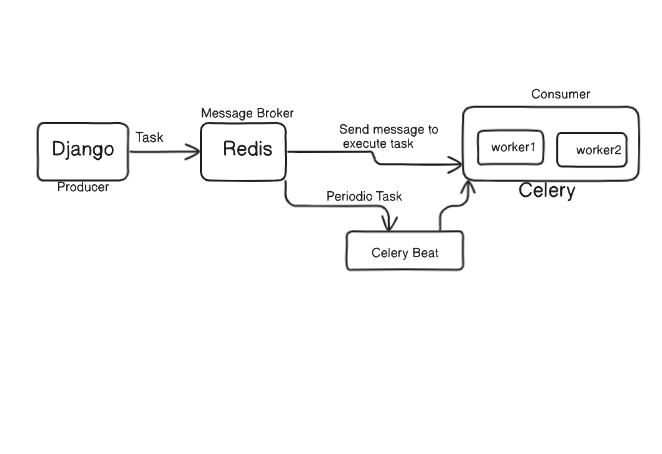Setting Up Celery, Celery Beat, Redis, and Django
 Deven
Deven 
This guide will walk you through the detailed process of setting up and using Celery with Redis in a Django application. We'll cover task creation, enqueuing tasks, using Redis as a message broker, processing tasks with Celery workers, and scheduling periodic tasks using Celery Beat.
Overview
Celery: A task queue for managing and executing asynchronous tasks.
Celery Beat: A scheduler for periodic tasks.
Redis: A message broker to store and manage task queues.
Django: A web framework to create and manage web applications.
Step-by-Step Guide
1. Install Required Packages
First, install the necessary packages using pip:
pip install celery redis django
2. Configure Django Project
Create a Django project and application if you haven't already:
django-admin startproject myproject
cd myproject
django-admin startapp myapp
3. Setup Celery
Create a celery.py file in your project directory (myproject/celery.py) to configure Celery:↳
# myproject/celery.py
from __future__ import absolute_import, unicode_literals
import os
from celery import Celery
# Set the default Django settings module for the 'celery' program.
os.environ.setdefault('DJANGO_SETTINGS_MODULE', 'myproject.settings')
app = Celery('myproject')
# Using a string here means the worker doesn't have to serialize
# the configuration object to child processes.
app.config_from_object('django.conf:settings', namespace='CELERY')
# Load task modules from all registered Django app configs.
app.autodiscover_tasks()
@app.task(bind=True)
def debug_task(self):
print(f'Request: {self.request!r}')
4. Ensure Celery Loads When Django Starts
Modify the __init__.py file in your project directory (myproject/__init__.py):
# myproject/__init__.py
from __future__ import absolute_import, unicode_literals
# This will make sure the app is always imported when
# Django starts so that shared_task will use this app.
from .celery import app as celery_app
__all__ = ('celery_app',)
5. Configure Django Settings
Add the Celery and Redis configurations to your Django settings (myproject/settings.py):
# settings.py
CELERY_BROKER_URL = 'redis://127.0.0.1:6379/0'
CELERY_RESULT_BACKEND = 'redis://127.0.0.1:6379/0'
CELERY_ACCEPT_CONTENT = ['json']
CELERY_TASK_SERIALIZER = 'json'
CELERY_RESULT_SERIALIZER = 'json'
CELERY_TIMEZONE = 'UTC'
6. Define Tasks
Create tasks in your Django app (myapp/tasks.py):
# myapp/tasks.py
from celery import shared_task
@shared_task
def add(x, y):
return x + y
@shared_task
def some_periodic_task():
# Task code here
pass
7. Enqueue Tasks
Enqueue tasks from your Django views or other parts of your application (myapp/views.py):
# myapp/views.py
from django.http import JsonResponse
from .tasks import add
def my_view(request):
result = add.delay(4, 4) # Enqueues the task to Redis
return JsonResponse({'task_id': result.id})
8. Setup Celery Beat for Periodic Tasks
Configure periodic tasks in celery.py:
# myproject/celery.py
from celery.schedules import crontab
app.conf.beat_schedule = {
'add-every-30-seconds': {
'task': 'myapp.tasks.add',
'schedule': 30.0,
'args': (16, 16)
},
'run-every-monday-morning': {
'task': 'myapp.tasks.some_periodic_task',
'schedule': crontab(hour=7, minute=30, day_of_week=1),
'args': ()
},
}
app.conf.timezone = 'UTC'
add-every-30-seconds: This task runs every 30 seconds and calls theaddfunction with the arguments16and16.run-every-monday-morning: This task runs every Monday at 7:30 AM and calls thesome_periodic_taskfunction without any arguments.
9. Start Celery Worker and Celery Beat
Start a Celery worker to process tasks:
celery -A myproject worker --loglevel=info
Start Celery Beat to schedule periodic tasks:
celery -A myproject beat --loglevel=info
Alternatively, you can run both a worker and beat in one command:
celery -A myproject worker -B --loglevel=info
10. Monitoring and Management
Flower
Flower is a real-time web-based monitoring tool for Celery.
Install Flower:
pip install flower
Run Flower:
celery -A myproject flower
Access Flower in your web browser at http://localhost:5555.
Redis CLI
Inspect the queues and tasks using Redis CLI.
Start the Redis CLI:
redis-cli
Example commands:
KEYS *: Lists all keys in the Redis database.LLEN celery: Shows the number of tasks in theceleryqueue.
Example Django Project Structure
Here's an example directory structure for a Django project with Celery tasks:
myproject/
__init__.py
settings.py
urls.py
wsgi.py
celery.py
myapp/
__init__.py
tasks.py
views.py
Summary
Install Packages: Install Celery and Redis.
Configure Celery: Create and configure
celery.py.Load Celery: Ensure Celery loads with Django.
Configure Settings: Add Celery and Redis configurations in Django settings.
Define Tasks: Create tasks in your Django app.
Enqueue Tasks: Use the
delaymethod to add tasks to the Redis queue.Periodic Tasks: Configure periodic tasks with Celery Beat.
Start Processes: Run Celery worker and beat to process tasks and schedule periodic tasks.
Monitoring: Use tools like Flower and Redis CLI to monitor and manage tasks.
By following these detailed steps, you can set up a Django application to handle asynchronous tasks and periodic tasks using Celery, Celery Beat, and Redis. This setup helps in managing background jobs efficiently and ensures your application remains responsive.
#######################BONUS :D #############################
Retrieving the Result:
- The task ID (
result.id) can be used to query the result.
from celery.result import AsyncResult
def get_task_result(task_id):
result = AsyncResult(task_id)
if result.ready():
return result.result # The result of the task
else:
return 'Task not yet completed'
The End :D
Subscribe to my newsletter
Read articles from Deven directly inside your inbox. Subscribe to the newsletter, and don't miss out.
Written by

Deven
Deven
"Passionate software developer with a focus on Python. Driven by a love for technology and a constant desire to explore and learn new skills. Constantly striving to push the limits and create innovative solutions.”